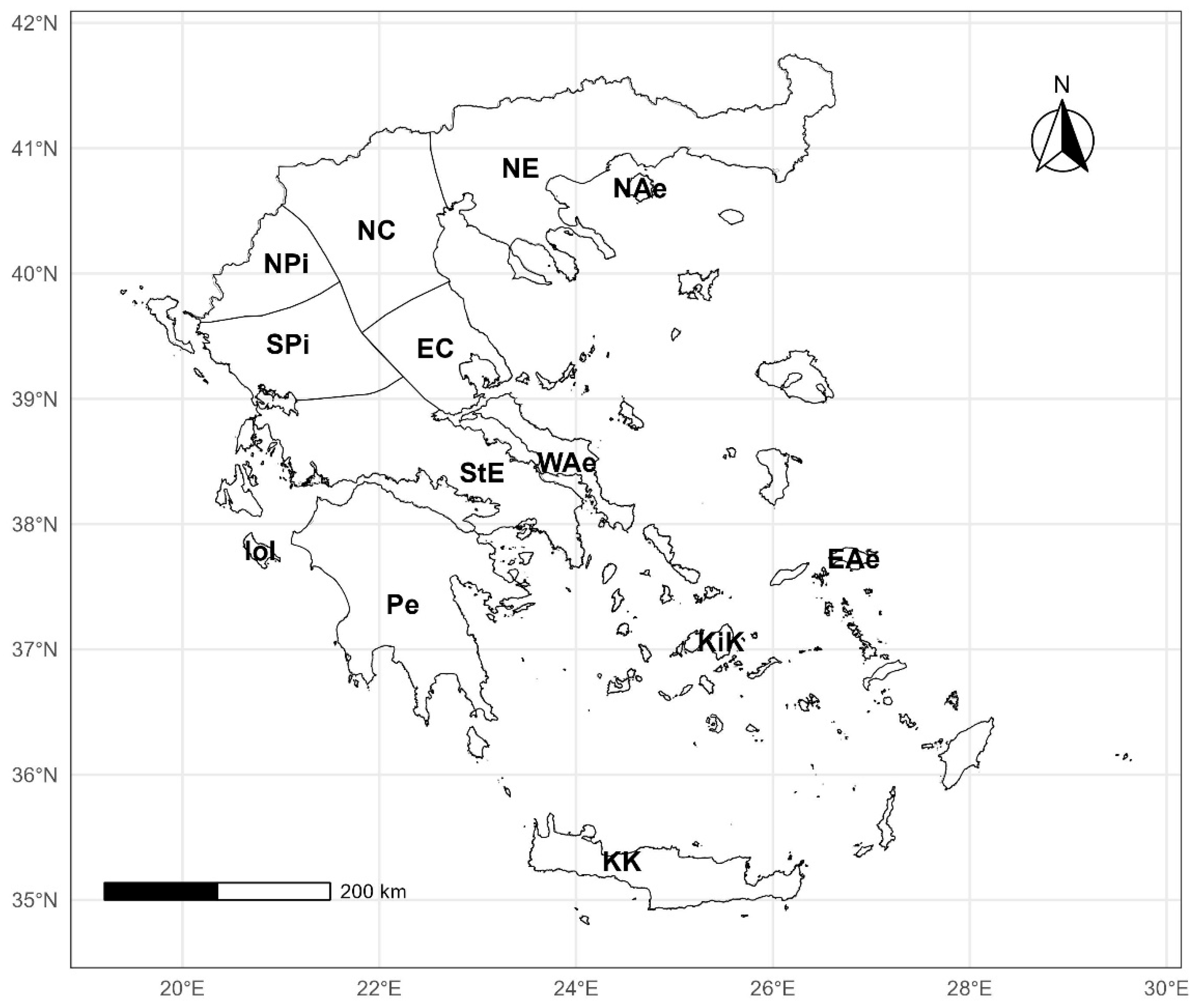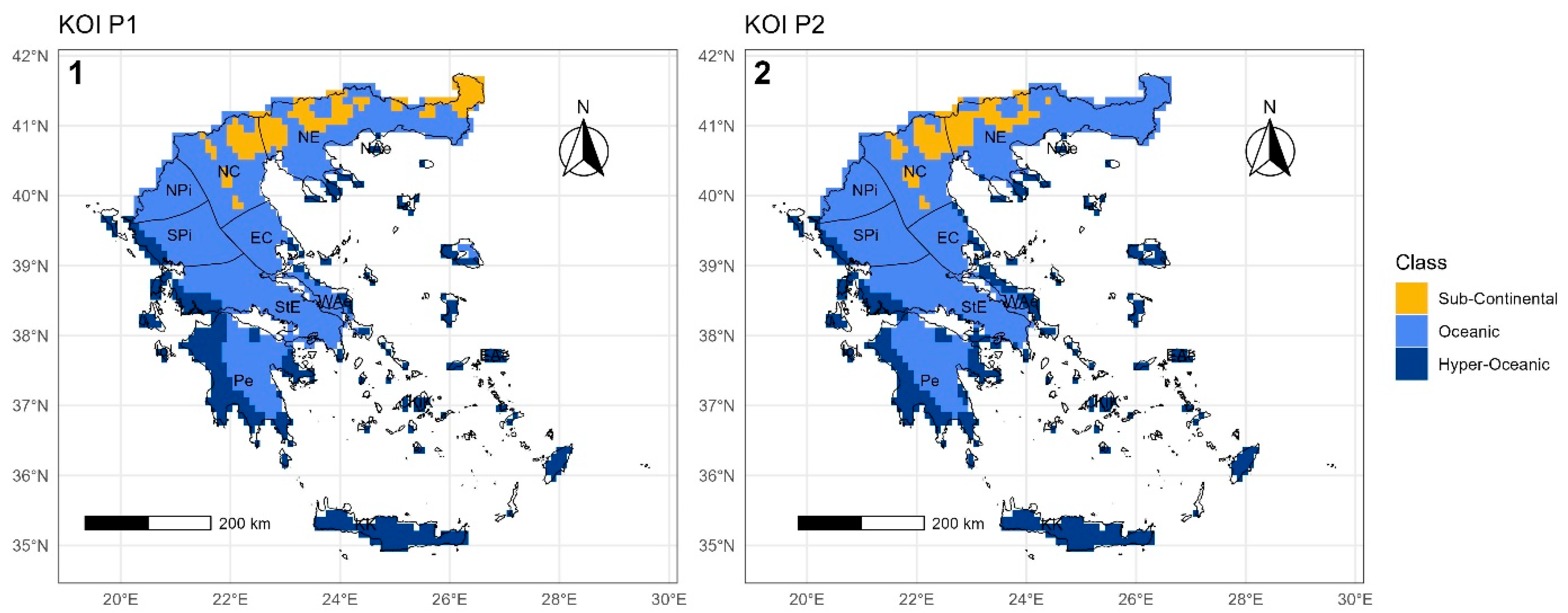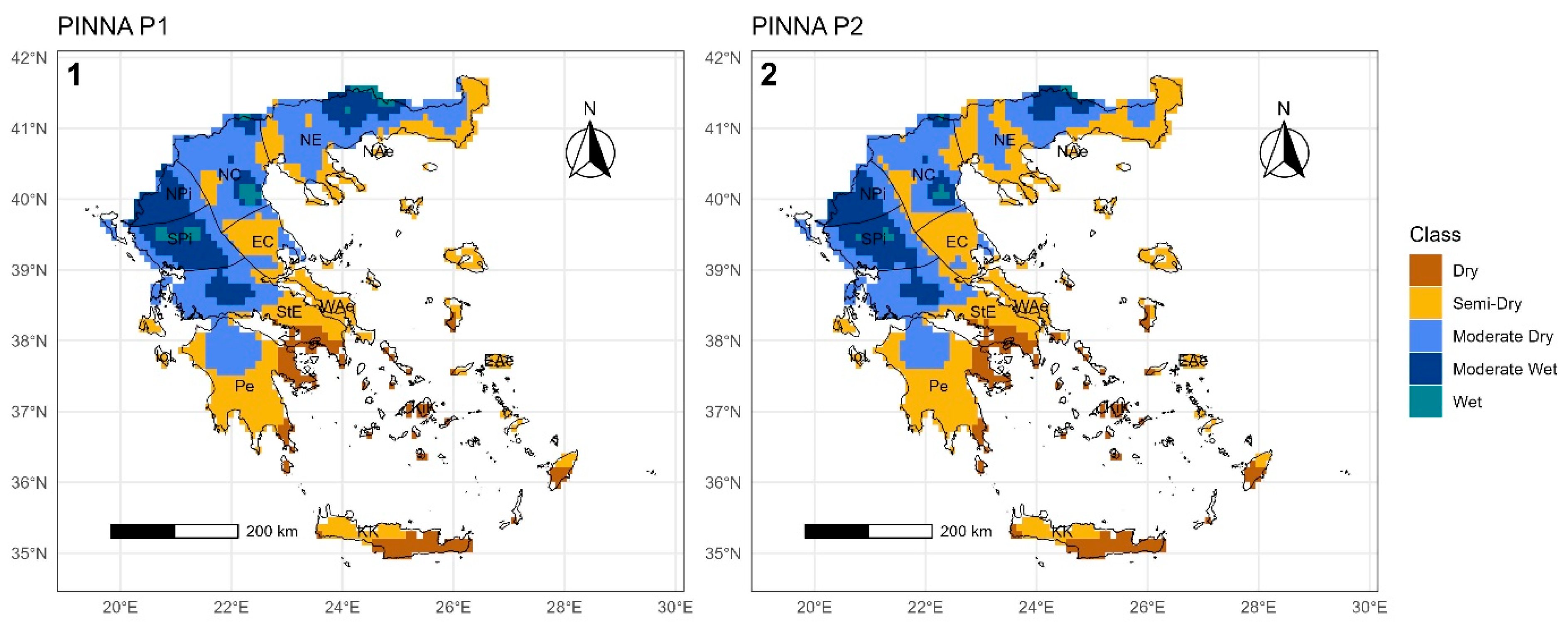An Evolution of Climate in Greece by the Johansson, Kerner and Pinna Indices †
Abstract
1. Introduction
2. Materials and Methods
2.1. Study Area
2.2. Data and Methods
3. Results and Discussion
4. Conclusions
- Based on the JCI, Greece is mostly classified as having a “Moderate Marine” climate; however, clear shifts towards the “Transitional” and “Continental” classes are found mostly on the northern and central areas of the country.
- Regarding the KOI, most of the country is classified as “Oceanic”. The “Hyper-Oceanic” category, predominantly describing the western coastline, demonstrated a spatial decline over the western regions in p2, while the eastern coastline displays a spatiotemporal increase in the same class.
- Based on the PINNA classification, Greece is characterized as mostly “Moderate Dry”, while showcasing all classes of the index. In p2, the “Semi-Dry” and “Dry” classes are spatially expanded, while the “Moderate Wet” and “Wet” classes are restricted.
- Overall, the phytogeographical regions that seem to have faced increased shifts towards drier classes are detected in the northern (NC, NPi, NC) and central (EC, StE, Wae) parts of the country. The climate of most island phytogeographical regions (IoI, KK, KiK) remains practically unchanged.
Author Contributions
Funding
Institutional Review Board Statement
Informed Consent Statement
Data Availability Statement
Conflicts of Interest
References
- Tuel, A.; Eltahir, E.a.B. Why Is the Mediterranean a Climate Change Hot Spot? J. Clim. 2020, 33, 5829–5843. [Google Scholar] [CrossRef]
- Droulia, F.; Charalampopoulos, I. Climate Evolution of Agricultural and Natural Areas of Southeastern Europe According to Pinna, Johansson and Kerner Climate Indices. Documentation on Territorial and Country Level. 2025. Available online: https://www.preprints.org/manuscript/202504.1193/v1 (accessed on 18 April 2025).
- Georgoulias, A.K.; Akritidis, D.; Kalisoras, A.; Kapsomenakis, J.; Melas, D.; Zerefos, C.S.; Zanis, P. Climate change projections for Greece in the 21st century from high-resolution EURO-CORDEX RCM simulations. Atmos. Res. 2022, 271, 106049. [Google Scholar] [CrossRef]
- Charalampopoulos, I.; Droulia, F.; Kokkoris, I.; Dimopoulos, P. Projections on the Spatiotemporal Bioclimatic Change over the Phytogeographical Regions of Greece by the Emberger Index. Water 2024, 16, 2070. [Google Scholar] [CrossRef]
- Vlachogiannis, D.; Sfetsos, A.; Markantonis, I.; Politi, N.; Karozis, S.; Gounaris, N. Quantifying the Occurrence of Multi-Hazards Due to Climate Change. Appl. Sci. 2022, 12, 1218. [Google Scholar] [CrossRef]
- Lagouvardos, K.; Dafis, S.; Kotroni, V.; Kyros, G.; Giannaros, C. Exploring Recent (1991–2020) Trends of Essential Climate Variables in Greece. Atmosphere 2024, 15, 1104. [Google Scholar] [CrossRef]
- Nastos, P.T.; Zerefos, C.S. Climate Change and precipitation in Greece. Hell. J. Geosci. 2010, 45, 185–192. [Google Scholar]
- Varlas, G.; Stefanidis, K.; Papaioannou, G.; Panagopoulos, Y.; Pytharoulis, I.; Katsafados, P.; Papadopoulos, A.; Dimitriou, E. Unravelling Precipitation Trends in Greece since 1950s Using ERA5 Climate Reanalysis Data. Climate 2022, 10, 12. [Google Scholar] [CrossRef]
- Lagouvardos, K.; Papavasileiou, G.; Papagiannaki, K.; Dafis, S.; Galanaki, E.; Giannaros, T.; Koletsis, I.; Kotroni, V. Regional precipitation index: Method analysis and application over Greece. Atmos. Sci. Lett. 2023, 24, e1184. [Google Scholar] [CrossRef]
- Tsiros, I.X.; Nastos, P.; Proutsos, N.D.; Tsaousidis, A. Variability of the aridity index and related drought parameters in Greece using climatological data over the last century (1900–1997). Atmos. Res. 2020, 240, 104914. [Google Scholar] [CrossRef]
- Charalampopoulos, I.; Droulia, F.; Tsiros, I. Projecting Bioclimatic Change over the South-Eastern European Agricultural and Natural Areas via Ultrahigh-Resolution Analysis of the de Martonne Index. Atmosphere 2023, 14, 858. [Google Scholar] [CrossRef]
- Galanaki, E.; Giannaros, C.; Kotroni, V.; Lagouvardos, K.; Papavasileiou, G. Spatio-Temporal Analysis of Heatwaves Characteristics in Greece from 1950 to 2020. Climate 2023, 11, 5. [Google Scholar] [CrossRef]
- Zanis, P.; Katragkou, E.; Ntogras, C.; Marougianni, G.; Tsikerdekis, A.; Feidas, H.; Anadranistakis, E.; Melas, D. Transient high-resolution regional climate simulation for Greece over the period 1960–2100: Evaluation and future projections. Clim. Res. 2015, 64, 123–140. [Google Scholar] [CrossRef]
- Li, Y.; Qin, Y.; Rong, P. Evolution of potential evapotranspiration and its sensitivity to climate change based on the Thornthwaite, Hargreaves, and Penman–Monteith equation in environmental sensitive areas of China. Atmos. Res. 2022, 273, 106178. [Google Scholar] [CrossRef]
- del Río, S.; Álvarez-Esteban, R.; Alonso-Redondo, R.; Álvarez, R.; Rodríguez-Fernández, M.P.; González-Pérez, A.; Penas, A. Applications of bioclimatology to assess effects of climate change on viticultural suitability in the DO León (Spain). Theor. Appl. Clim. 2024, 155, 3387–3404. [Google Scholar] [CrossRef]
- Baltas, E. Spatial distribution of climatic indices in northern Greece. Meteorol. Appl. 2006, 14, 69–78. [Google Scholar] [CrossRef]
- Deniz, A.; Toros, H.; Incecik, S. Spatial variations of climate indices in Turkey. Intl J. Climatol. 2011, 31, 394–403. [Google Scholar] [CrossRef]
- Nistor, M.M. Spatial distribution of climate indices in the Emilia-Romagna region. Meteorol. Appl. 2016, 23, 304–313. [Google Scholar] [CrossRef]
- Aydinalp, C.; Cresser, M. The Effects of Global Climate Change on Agriculture. Am.-Eurasian J. Agric. Environ. Sci. 2008, 3, 672–676. [Google Scholar]
- Dianeosis; Georgakopoulos, T. The Consequences Of Climate Change in Greece. 2021. Available online: https://www.dianeosis.org/en/2021/12/the-consequences-of-climate-change-in-greece/ (accessed on 19 March 2025).
- Strid, A. Phytogeographia Aegaea and the Flora Hellenica Database. 1996. Available online: https://zobodat.at/pdf/ANNA_98BS_0279-0289.pdf (accessed on 15 March 2025).
- Yilmaz, M. Accuracy assessment of temperature trends from ERA5 and ERA5-Land. Sci. Total Environ. 2023, 856, 159182. [Google Scholar] [CrossRef] [PubMed]
- Wickham, H.; Averick, M.; Bryan, J.; Chang, W.; McGowan, L.D.; François, R.; Grolemund, G.; Hayes, A.; Henry, L.; Hester, J.; et al. Welcome to the Tidyverse. J. Open Source Softw. 2019, 4, 1686. [Google Scholar] [CrossRef]
- Hijmans, R.; Bivand, R. Description of the Methods in the Terra Package—Terra-Package. Available online: https://rspatial.github.io/terra/reference/terra-package.html#authors (accessed on 22 March 2025).
- Philandras, C.M.; Nastos, P.T.; Repapis, C.C. Air temperature variability and trends over Greece. Glob. Nest J. 2008, 10, 273–285. [Google Scholar]
- Tzanis, C.; Koutsogiannis, I.; Phillipopoulos, K.; Deligiorgi, D. Recent climate trends over Greece. Atmos. Res. 2019, 230, 104623. Available online: https://www.sciencedirect.com/science/article/pii/S0169809518315801 (accessed on 25 February 2025). [CrossRef]
- Nastos, P.T.; Politi, N.; Kapsomenakis, J. Spatial and temporal variability of the Aridity Index in Greece. Atmos. Res. 2013, 119, 140–152. [Google Scholar] [CrossRef]




| Index | Value | Class |
|---|---|---|
| JCI | >20 | Marine |
| [20,32) | Moderate Marine | |
| [32–34] | Transitional | |
| >34 | Continental | |
| KOI | >20 | Hyper-Oceanic |
| (10,20] | Oceanic | |
| (0,10] | Sub-Continental | |
| PINNA | >40 | Wet |
| (30,40] | Moderate Wet | |
| (20,30] | Moderate Dry | |
| (10,20] | Semi-Dry | |
| (2.5,10] | Dry |
Disclaimer/Publisher’s Note: The statements, opinions and data contained in all publications are solely those of the individual author(s) and contributor(s) and not of MDPI and/or the editor(s). MDPI and/or the editor(s) disclaim responsibility for any injury to people or property resulting from any ideas, methods, instructions or products referred to in the content. |
© 2025 by the authors. Licensee MDPI, Basel, Switzerland. This article is an open access article distributed under the terms and conditions of the Creative Commons Attribution (CC BY) license (https://creativecommons.org/licenses/by/4.0/).
Share and Cite
Kiorouktsidou, A.; Droulia, F.; Charalampopoulos, I. An Evolution of Climate in Greece by the Johansson, Kerner and Pinna Indices. Environ. Earth Sci. Proc. 2025, 35, 26. https://doi.org/10.3390/eesp2025035026
Kiorouktsidou A, Droulia F, Charalampopoulos I. An Evolution of Climate in Greece by the Johansson, Kerner and Pinna Indices. Environmental and Earth Sciences Proceedings. 2025; 35(1):26. https://doi.org/10.3390/eesp2025035026
Chicago/Turabian StyleKiorouktsidou, Athina, Fotoula Droulia, and Ioannis Charalampopoulos. 2025. "An Evolution of Climate in Greece by the Johansson, Kerner and Pinna Indices" Environmental and Earth Sciences Proceedings 35, no. 1: 26. https://doi.org/10.3390/eesp2025035026
APA StyleKiorouktsidou, A., Droulia, F., & Charalampopoulos, I. (2025). An Evolution of Climate in Greece by the Johansson, Kerner and Pinna Indices. Environmental and Earth Sciences Proceedings, 35(1), 26. https://doi.org/10.3390/eesp2025035026







